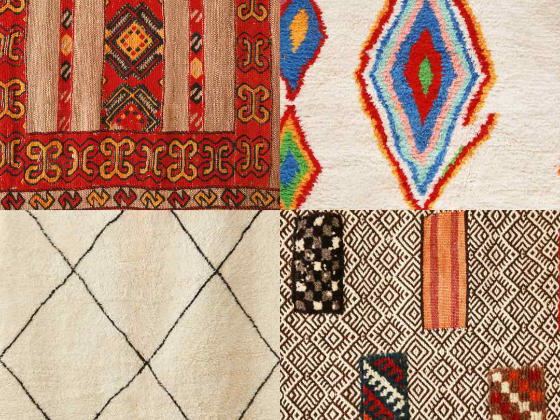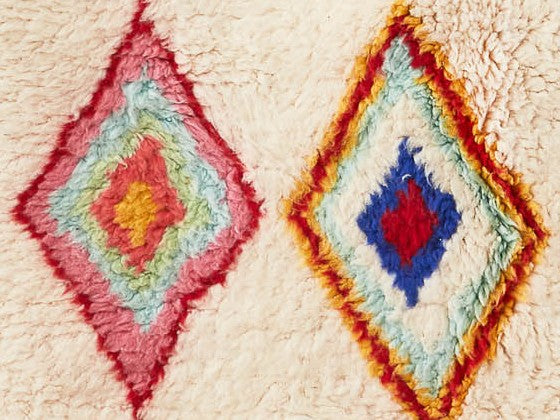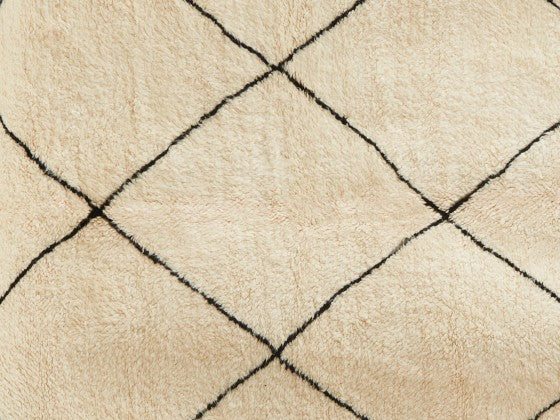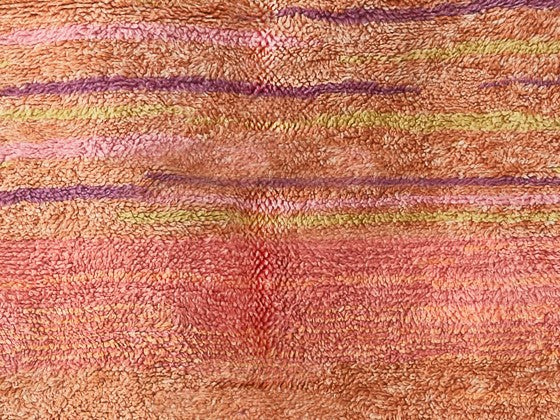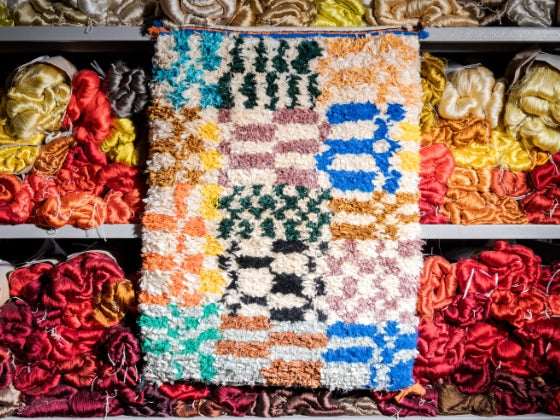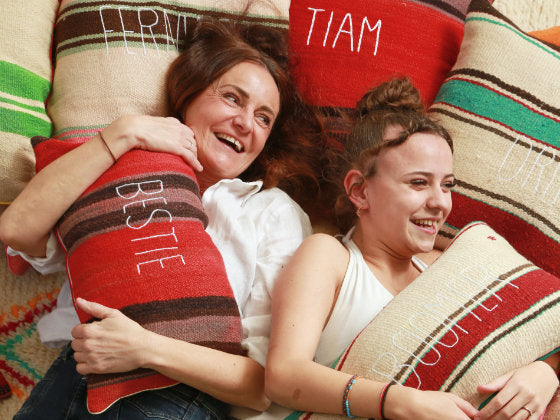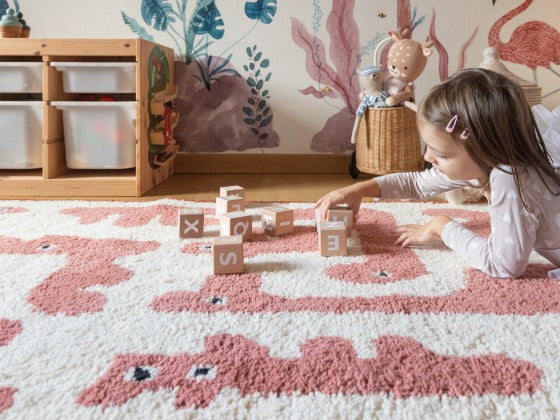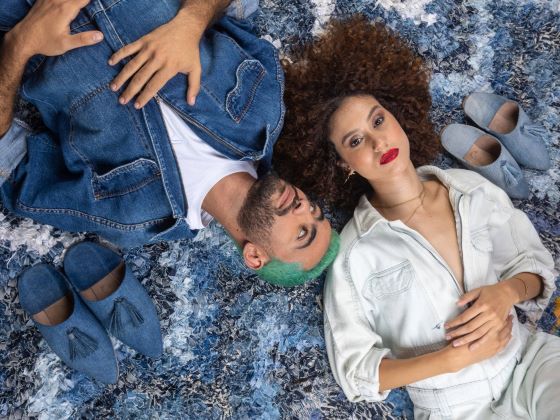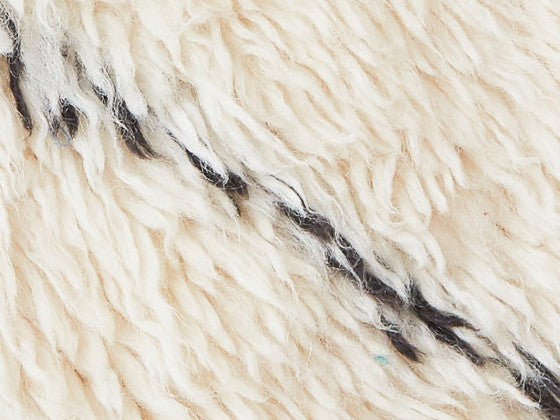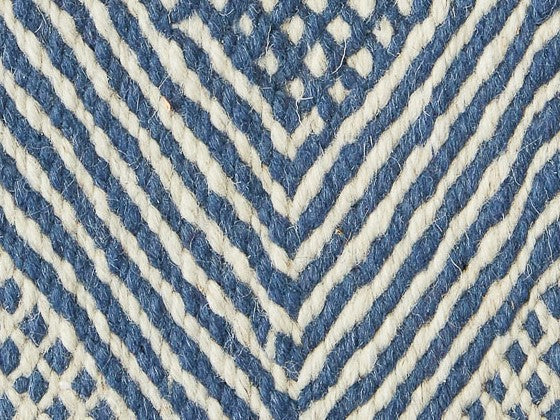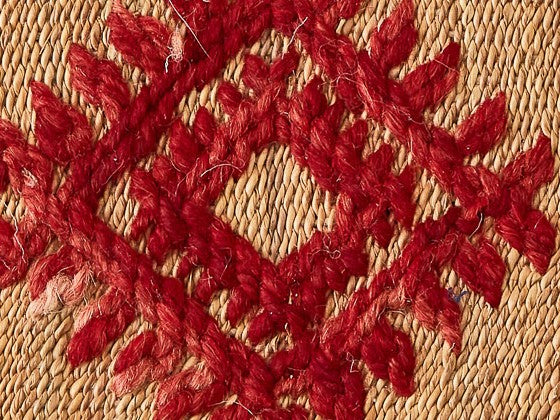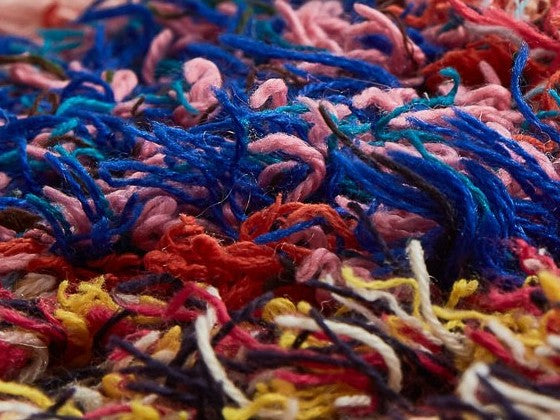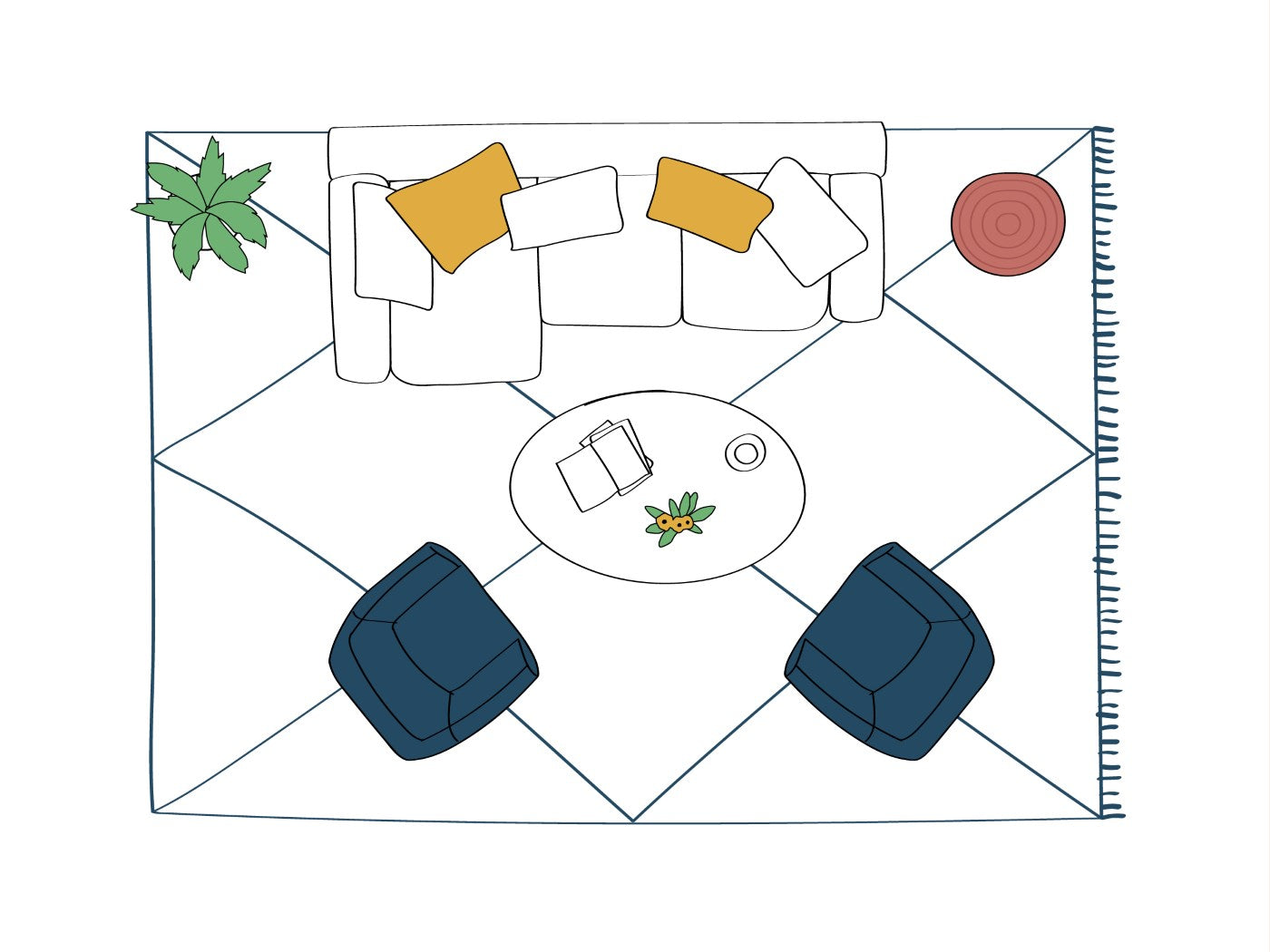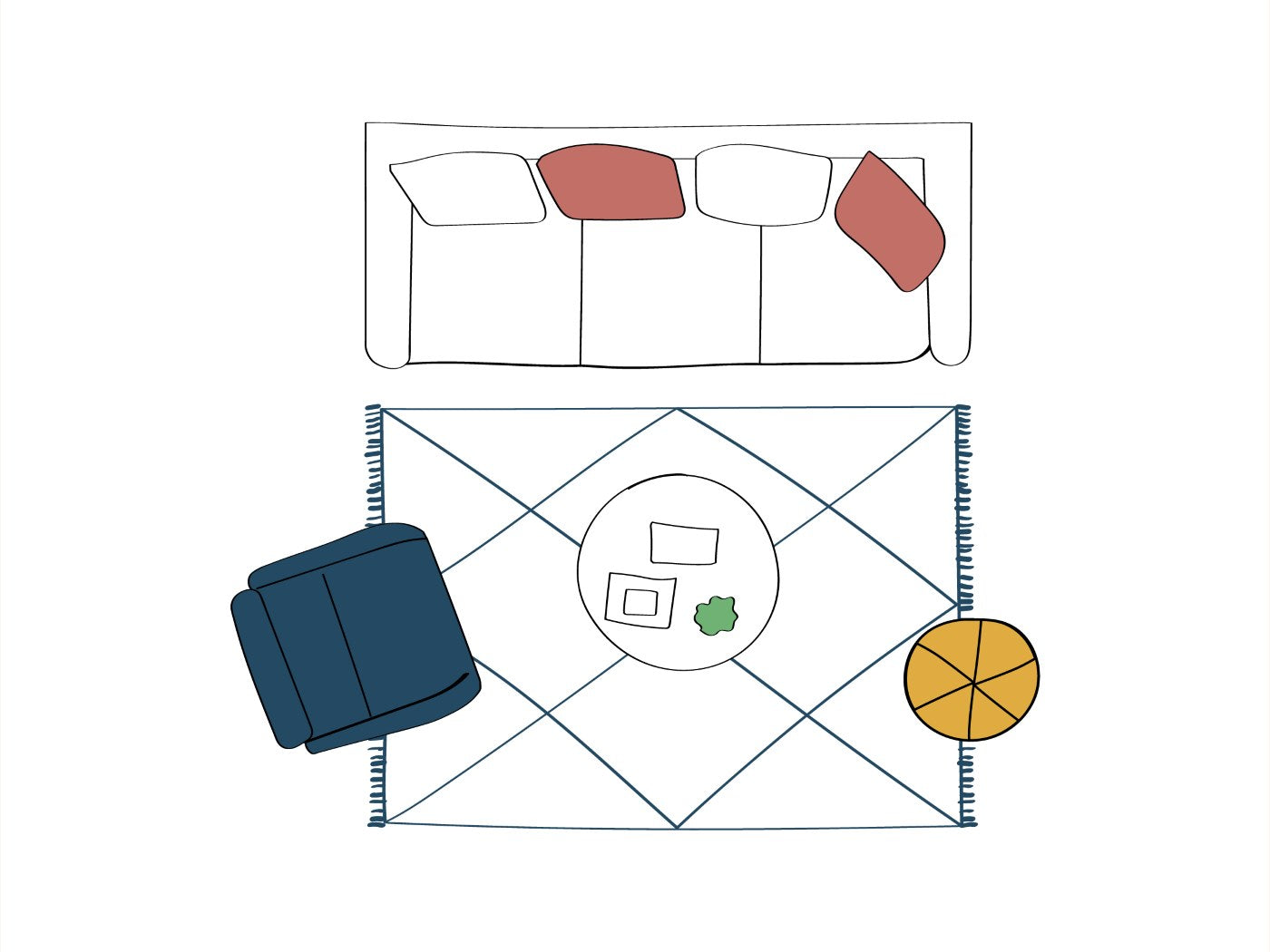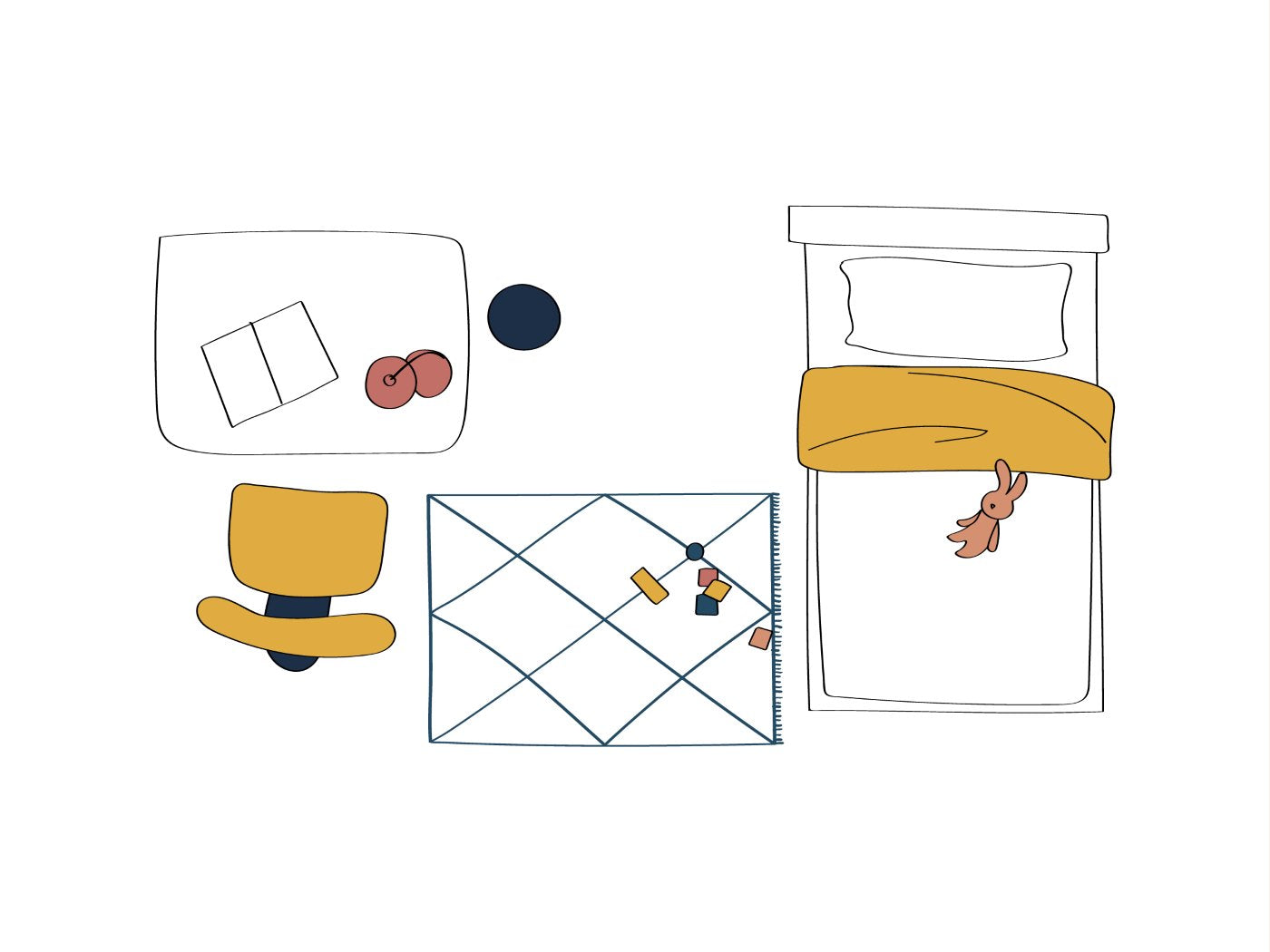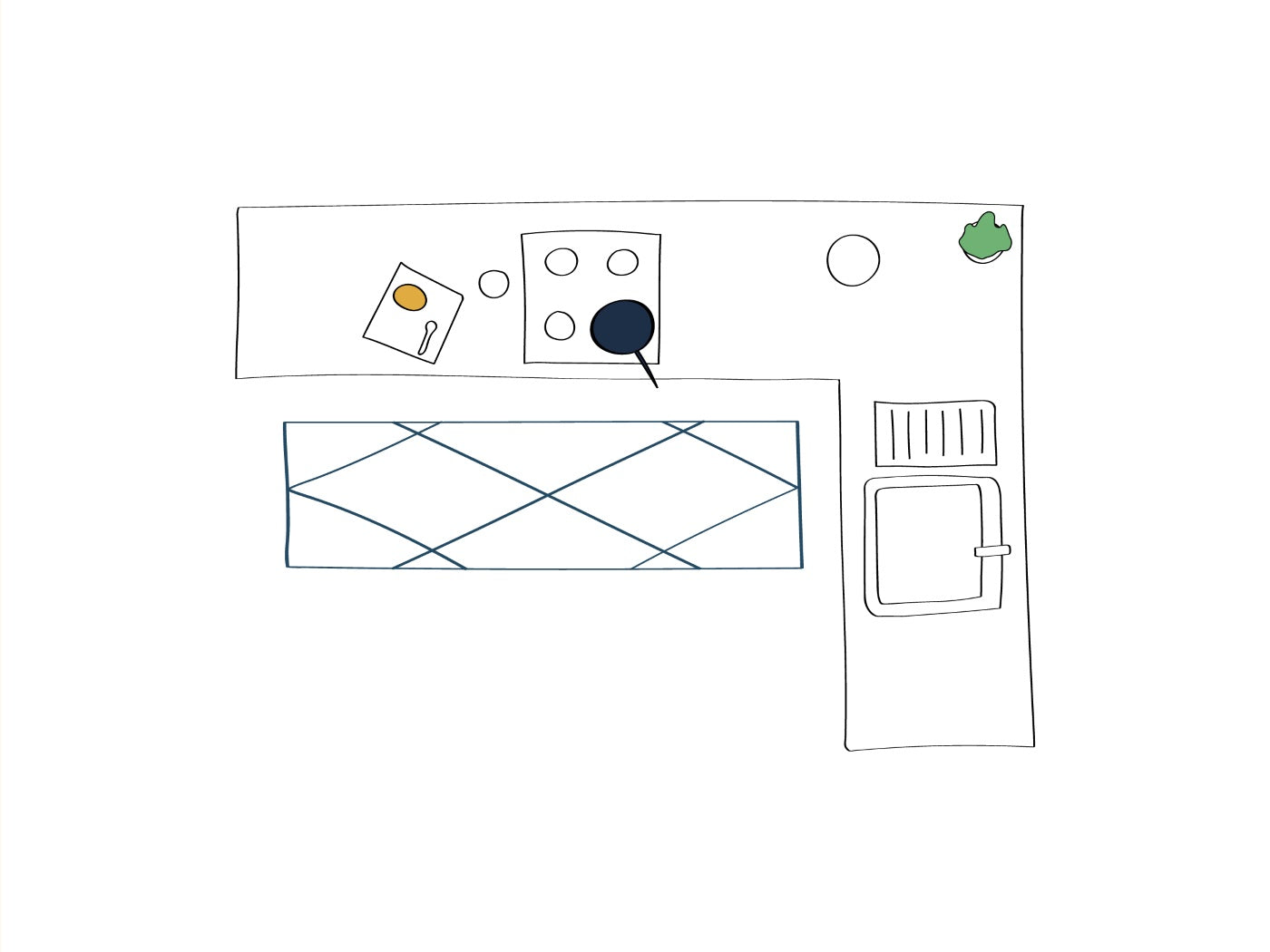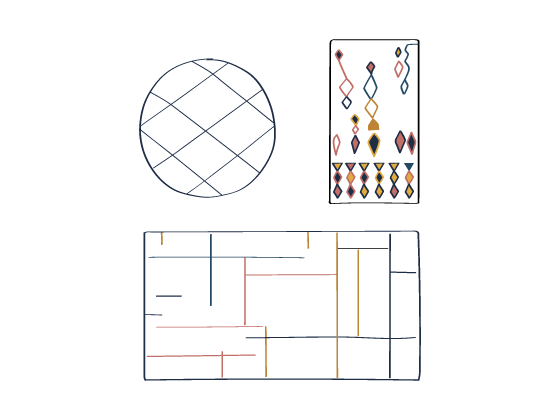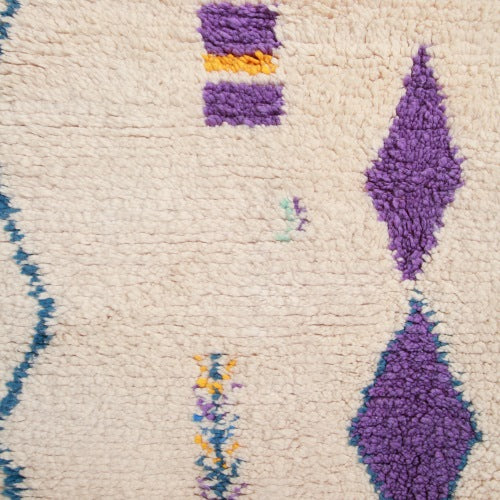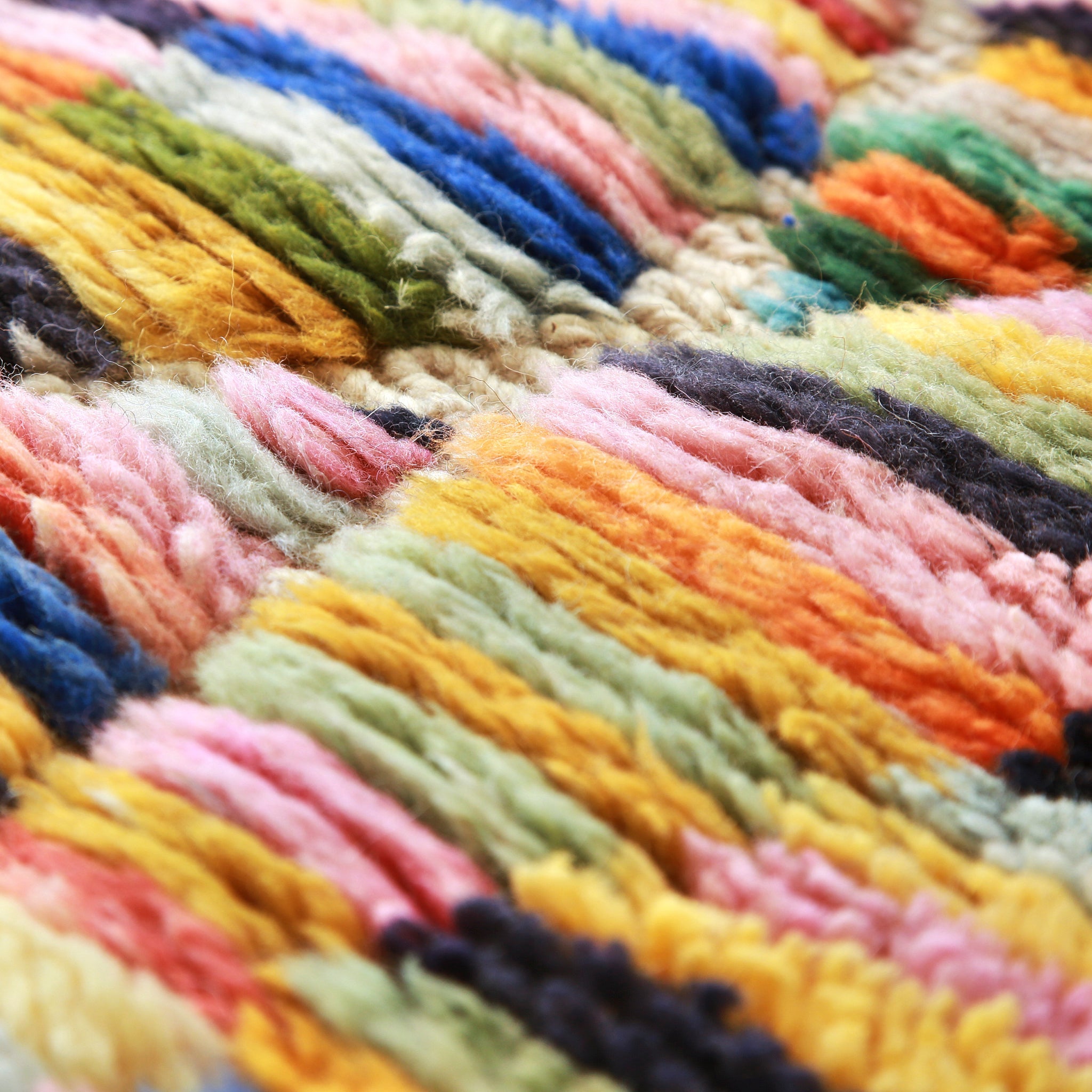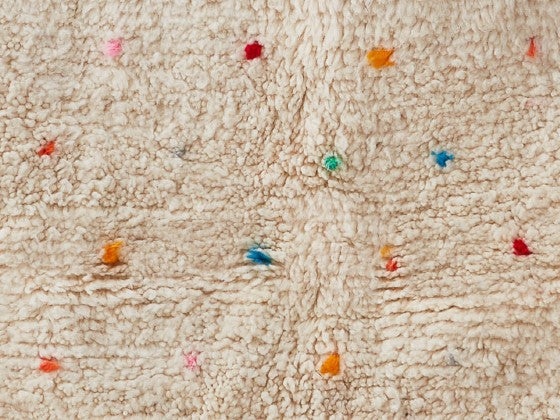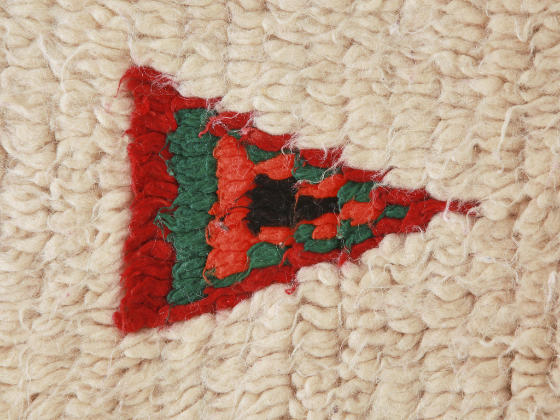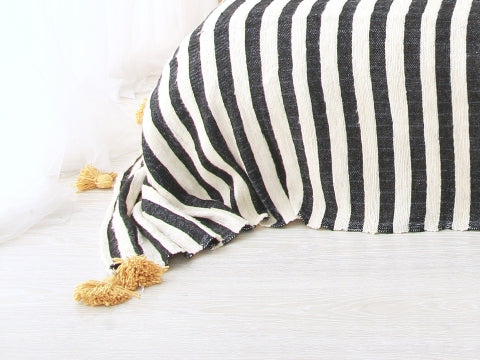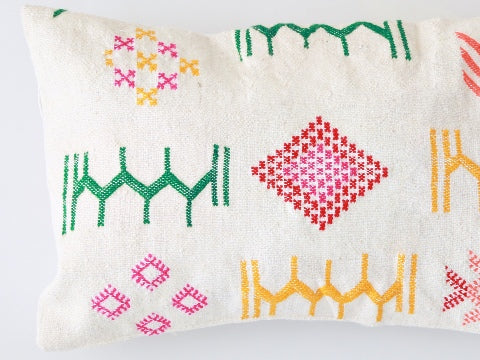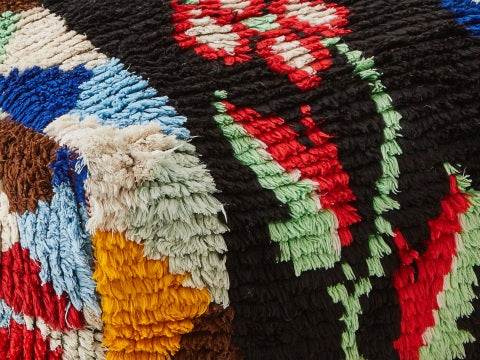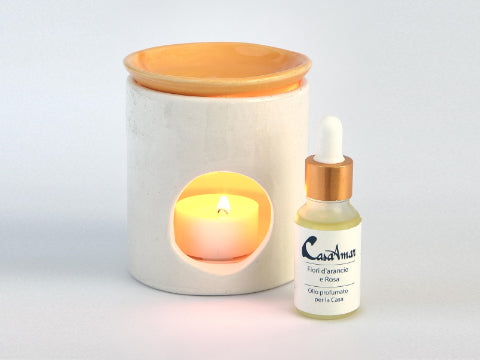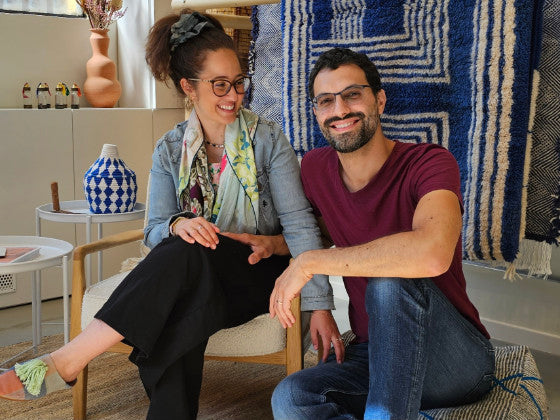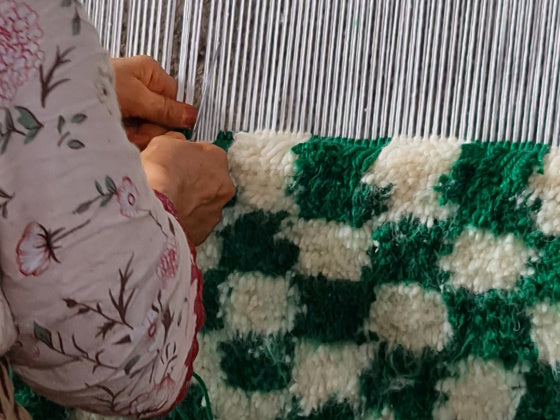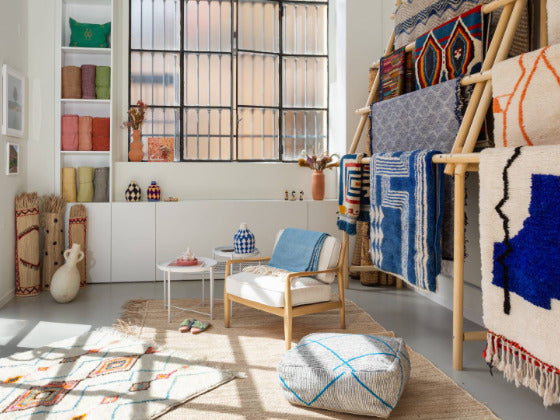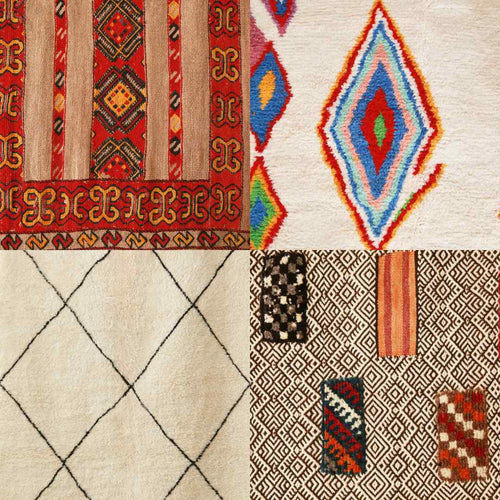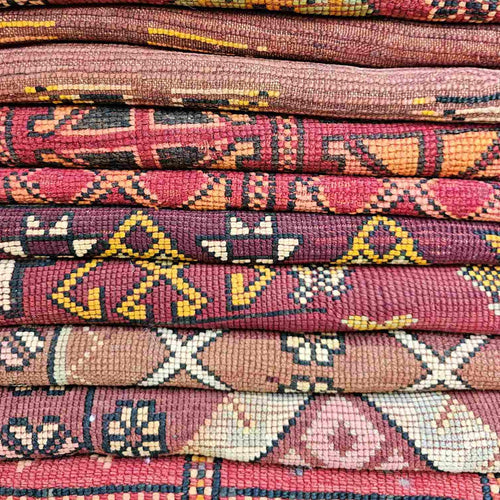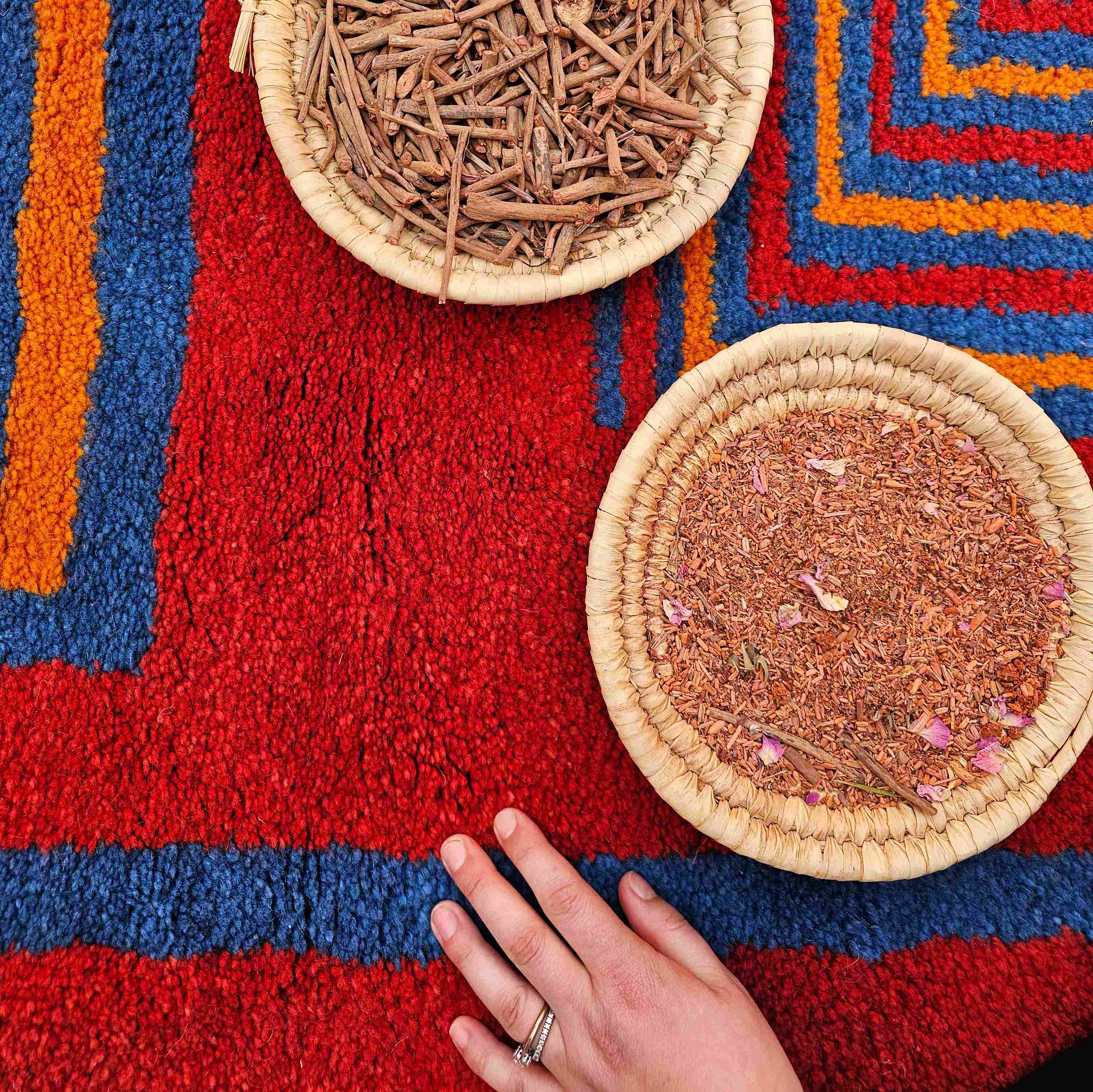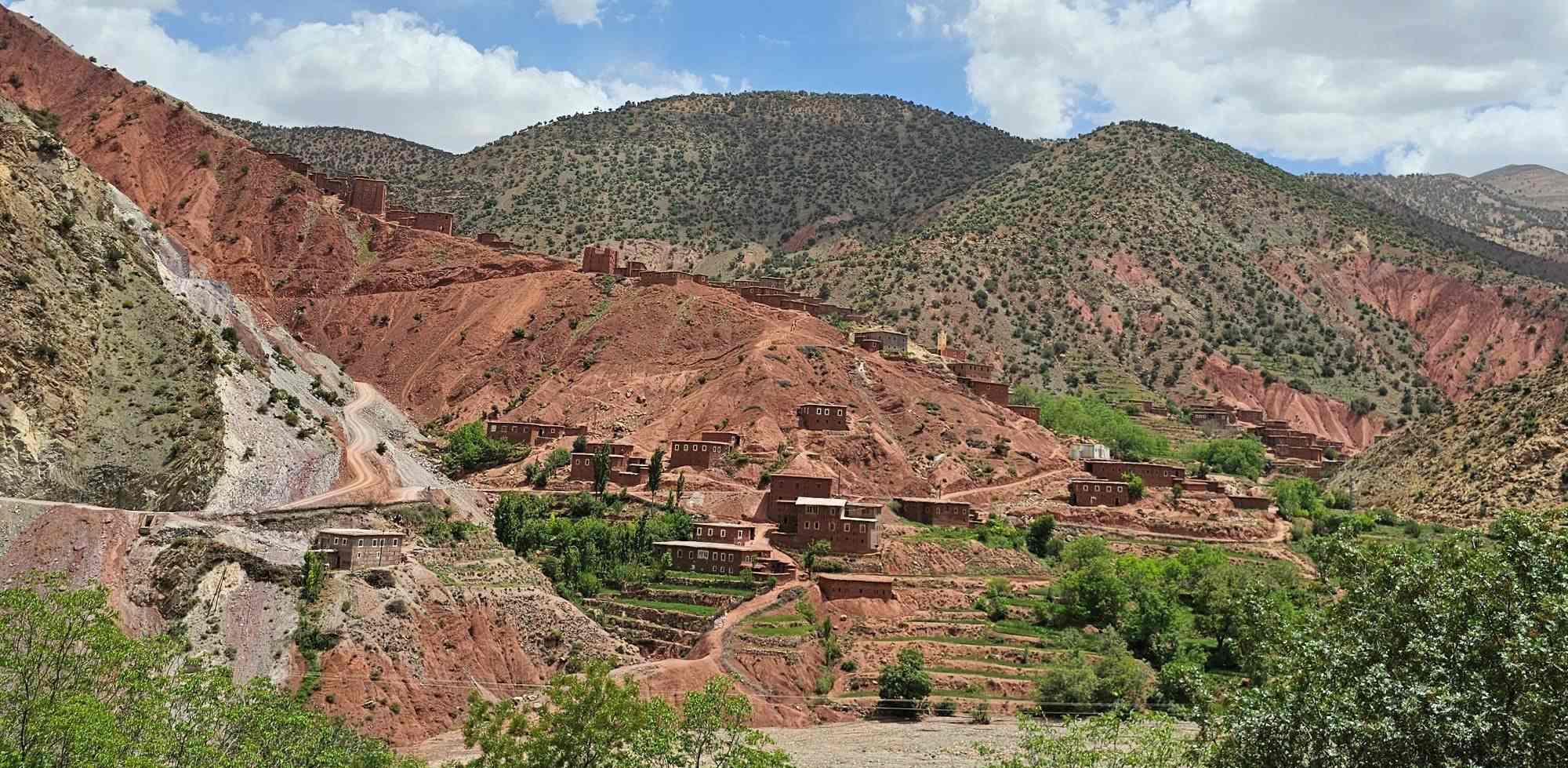What is a Moroccan rug called?
A Moroccan rug is commonly referred to as Berber rug. They are traditionally handwoven by Amazigh women in communities scattered across the Atlas Mountains.
While many people still refer to them as “Berber rugs”, the correct term is Amazigh, which is how these communities define themselves.
“Berber” is widely recognized internationally, but it comes from an outsider’s label, whereas Amazigh is the authentic name used by the people who weave these rugs.
Each region developed its own weaving style and identity, so you’ll also hear names like Beni Ourain, Azilal, Boujad, and many others you’ll discover in this guide.
What are the different styles of Moroccan rugs?
Below is a brief comparison of major Moroccan rug families by region, distinctive features, and best uses.
Click or tap a name to jump to the detailed section.
| Rug Name | Region/Origin | Distinctive Feature |
|---|---|---|
| Beni Ourain | Middle Atlas | Cream/ivory wool with dark diamond lattice |
| Kilim / Hanbel | Various regions | Flat-weave, lightweight, reversible |
| Beni Mrirt | Middle Atlas (Mrirt) | Dense, plush pile; refined hand |
| Boucherouite | Various (rural/urban) | Upcycled rag rugs; mixed textiles; bold color |
| Boujaad | Haouz / Chaouia-Ouardigha | Warm pinks, reds, oranges; vintage patina |
| Azilal | High Atlas | Playful, colorful abstract motifs on light ground |
| Taznakht | Ouarzazate / Anti-Atlas | Fine knotting; saffron/golden tones; classic motifs |
| Zanafi | Ouarzazate region | Flat-weave with bold black–white diagonals/chevrons |
| Akhnif | Taznakht (Ouarzazate, Anti-Atlas) | Flat-woven; very fine repeated embroidered micro-motifs; neat, refined compositions |
| Kharita | Taznakht (Ouarzazate, Anti-Atlas) | Flat-weave; dense, map-like fields of tiny color patches; complex, skilled work |
| Hassira Mat | Morocco (various; Saharan trade) | Palm/reed mats; flat and breathable |
| Glaoui | Taznakht / High–Anti-Atlas | Mixed techniques: pile + flat-weave + embroidery |
| Chichaoua | Chichaoua (Marrakech–Essaouira) | Earthy reds/oranges; simple geometrics |
| Zemmour | Central / Middle Atlas | Red fields; diamond lattices; tribal symbols |
| Zayane | Khénifra / Middle Atlas | Dense pile; strong contrast; tribal lozenges |
| Zindekh | Various (upcycled plastic flour/rice sacks) | Small-format; sewn/knotting on plastic base or punch needle; bold abstracts. Great wall art, sofa-bed accents, small entry mats |
Names, styles, origins: what you’ll find in this guide
This guide is an evolving encyclopedia of Moroccan rugs, mats, and carpets. This is not an easy task, nor is it a job we take lightly, because the variety of these artefacts is exceptionally wide. We will introduce you to them in detail and help you make an informed choice, favouring authenticity and ethical purchasing.
And now...let us picture ourselves on a flying rug, transported to the heart of a fascinating and ancient culture: that of Morocco!
Before we begin: what do we mean when we talk about "authentic Moroccan carpets"?
...and why Moroccan, Berber, and Amazigh are not styles
Moroccan, Berber, Amazigh - as well as African or ethnic - are not the names of a type of decoration, pattern, or fabric made in a certain way.
First things first: a Moroccan rug is a rug handcrafted in Morocco.
This is a very specific geographical area, which corresponds to today's Morocco or the north-western part of the Maghreb, located near the Atlas mountain range.
Seems obvious? Unfortunately, it isn't.
Often, many rugs labelled as Berber are actually produced outside the country (e.g., Pakistan, India, Turkey) and are not handmade, but are called by this name simply because they have a pattern reminiscent of traditional North African motifs.
Provenance, authenticity, and responsible purchasing are important to us.
We must be careful because behind these so-called "Berber or Moroccan-style rugs", which are passed off as handicrafts, there is often an industry that pays little attention to workers' rights.
In addition, they are often industrially manufactured using materials sourced from untraceable sources and processed with dyes that are not always safe.
Origins, uses, materials, techniques, and patterns
🔎 At a glance
- Origins: Atlas Mountains; nomadic and semi-nomadic pastoral communities. Hand-knotting attested since the 8th century; first woven for everyday use later traded and made famous worldwide by 20th-century designers and architects.
- Materials: mostly sheep’s wool; goat/dromedary can be found in vintage pieces; cotton or other textiles (upcycled pieces); straw and wooden mats.
- Constructions: long-pile (hand-knotted) and flat-weave plus upcycled rag rugs made from recycled textiles.
- Patterns and motifs: diamonds, lozenges, traditional Berber symbols, grids, zigzags, squares, lines, chevrons and crosses, medallions, asymmetrical geometric layouts.
- Palette: varies. Traditionally white/ivory wool or coloured with earth tones derived from natural pigments available in the area. Today we find single-colour, two-colour and multicolour pieces.
- Traditional uses: floor coverings, bed blankets, mattresses, tent liners, wall hangings, prayer mats and saddle blankets.
Origins

Moroccan rugs are different from those made elsewhere in North Africa, such as in Tunisia or Egypt. Hand-knotting in Morocco is documented as early as the 8th century, well before similar techniques spread widely across the region. Their broader diffusion came later with trade and, in the 20th century, thanks to interest from internationally renowned designers and architects such as Le Corbusier, Alvar Aalto, and Eames.
📖 We have covered them in our guide to 20th-century designers and how they incorporated Moroccan rugs into their work.
The art of rug-making took root in the Atlas Mountains (ⵉⴷⵓⵔⴰⵔ ⵏ ⵓⴰⵟⵍⴰⵙ, Idurar n Waṭlas; Arabic جبال الأطلس, Jibāl Al-Aṭlas), where nomadic and semi-nomadic communities tied to pastoralism settled. Influenced by contact with Persian traders and favored by the quality of local sheep’s wool, they began weaving rugs for private, everyday use, and only later for trade.
Among the cultural heritage passed down from generation to generation are ancient symbols and geometric motifs. These reflect daily life and personal histories, as well as universal themes such as fortune, fertility, nature, femininity, and protection from evil influences. With the advent of Islam, arabesque and geometric patterns further shaped the decorative vocabulary, giving rise to unique, unmistakable works.
Today tribes are no longer organized as they once were but they have managed to pass down a millennia-old weaving tradition from generation to generation, family to family.
Each rug tells a story, signaling the weaver’s social background, origin and spiritual beliefs. Every piece is a one-of-a-kind work of art woven with skill, patience and creativity. They often hold meanings only the weaver herself can fully read!
Traditional uses and functions
What we often treat as a décor item is, for these communities, living heritage, and a true investment of time and resources.
Uses have long varied by place and custom, blending practicality with spirituality. In Morocco’s climate, wool rugs provide thermal comfort, insulating against heat and cold. They have served as bed blankets, floor coverings, mattresses, and tent liners. They also appear as saddle blankets, and in a small, portable format for prayer. As wall tapestries, they take on a more aesthetic role, much like today’s decorative use in interiors.
Materials and workmanship
Even today, Moroccan rugs are woven almost exclusively in sheep’s wool. This exceptional wool is naturally soft, lustrous, and typically ivory. It can be dyed with natural or plant-based pigments. In vintage pieces, you can find goat and dromedary wool.
Undyed black or dark fleeces are also used to create contrast.
Depending on how are they made, carpets can be long-pile or flat-woven. There are also upcycled pieces crafted from recycled textiles.
Most Moroccan rugs use hand-knotted and hand-dyed wool or virgin wool from local sheeps. Other natural materials, such as cotton or silk may also be used. Within the broader Moroccan tradition, you will also find straw and wooden mats.
Weavers work on horizontal or vertical looms and follow techniques, traditions, and motifs passed down through generations. Many do not use pattern charts: they weave intuitively, relying on honed skills and memory, which results in truly unrepeatable pieces.
Colors and patterns

Moroccan rugs are known for vibrant colors or geometric designs on light or white grounds (the natural shade of wool). You’ll also find multicolored wool rugs and many patterns based on diamonds or traditional symbols, which are especially popular.
📖 You can read more about symbolism, regional variations, and authenticity checks in our guide to Berber rugs.
Complete list of Moroccan rug styles
Beni Ourain | Morocco’s most iconic rugs

Beni Ourain rugs (also spelled Beni Ouarain) are the most well-known Moroccan rugs. Their black criss-cross diamond pattern on an ivory ground has become a modern classic, especially in Nordic-inspired interiors.
🔎 At a glance
- Origin: Amazigh tribes, North-Eastern Morocco
- Material: undyed virgin wool (ivory/cream in traditional pieces); dyed wool (modern pieces)
- Look: dark diamonds on a light ground (traditional); colorful designs (modern)
- Pile: long / medium / short, soft, dense
- Sizes: from small to large
Names & technique
The name comes from a group of Amazigh tribes in north-eastern Morocco, historically devoted to sheep herding. Using the prized wool of their flocks, they’ve woven for centuries rugs that embody a living craft tradition.
Materials
Classic Beni Ourain are long-pile pieces in soft, thick, undyed virgin wool (from ivory to creamy white). Contemporary versions now also appear in colours.
Patterns & palette
Simple dark geometric motifs, typically diamonds / rhombuses, on a light ground have made them much loved and often copied (to the point of fuelling a market of counterfeit carpets).
Styling & use
Beni Ourains come in a wide range of sizes, including large formats. Traditionally, they insulated entire floors against the cold (Matisse fondly called them “the white giants”). With their minimalist geometry, they work across styles. Their dense pile feels cushioned underfoot and tends to stay in place.
Kilim and Hanbel Rugs | Morocco’s flat-weave tradition

Kilim is the widely used term for flat-woven rugs with no pile. In Morocco, these flat weaves are also called Hanbel. Light, durable, and versatile, they look great on their own as well as layered over pile rugs. Many people—including us—love hanging them on the wall as tapestries or headboards.
🔎 At a glance
- Names: Kilim (generic); Hanbel in Morocco
- Construction: flat weave (no pile), tightly interlaced warp and weft
- Materials: hand-spun sheep’s wool (weft) with wool or cotton warps; occasional cotton; “sabra” (a mythical cactus silk, today mostly viscose or rayon)
- Look: diamonds, zigzags, triangles, symbols, lozenges, raised knot details, corded lines, thread embroideries
- Handle: lightweight, often reversible; easy to move and layer
Names & technique
“Kilim” is a Turkish loanword used globally for flat weaves. In Morocco, the local term Hanbel refers to the same pileless construction. The weft (the coloured yarns forming the visible pattern) is tightly interlaced with the warp to create a smooth, flat surface. Warps reveal themselves at the ends as fringes, tied to secure the weave over time.
Materials
Most Moroccan Hanbel use hand-spun sheep’s wool for the weft, with wool or cotton warps. Cotton can also appear in the structure or patterning. You’ll sometimes see “sabra” mentioned: historically a plant fibre nickname, but in contemporary production it is almost always viscose.
Patterns & palette
Expect geometric designs like diamonds, zigzags, chevrons, triangles, medallions, eyes, stars, on neutral or high-contrast grounds. Some Moroccan flat weaves add raised embroidery for texture. Compared with Persian or Anatolian kilims (often earthier, sometimes floral), Moroccan Hanbel tend to favour bold geometry and graphic rhythm.
Styling & use
Their slim profile suits dining rooms for easy chair movement, hallways, and high-traffic areas as they are easy to clean. They’re great for layering over pile rugs, for summer swaps, or as wall hangings.
Beni Mrirt Rugs | Luxury from the Atlas

Beni Mrirt rugs originate from the region of the same name, in the High Atlas of Morocco. They are very similar to Beni Ourain: soft, with elegant and minimal dark geometric patterns on a neutral ground. Tones can be slightly more vivid, including bright orange or deep green.
🔎 At a glance
- Origin: Beni Mrirt region, High Atlas (Morocco)
- Construction: hand-knotted, very tight knotting for a dense, resistant pile
- Material: very fine, top-quality wool; soft, lustrous hand
- Look: neutral bases with refined dark geometrics; occasional stronger colour accents
- Finish: repeated washing that enhances softness and sheen
Names & technique
What distinguishes Beni Mrirt is the use of very fine, top-quality wool, hand-knotted with a skilled technique that employs very tight knots to create a dense and highly durable rug.
Materials
The wool is soft, bright, and hand-knotted, giving the surface a refined feel to the touch and firm support underfoot.
Patterns & palette
Designs are elegant and minimal, with geometric motifs on neutral backgrounds. The palette often includes vivid tones such as bright orange or dark green.
Finishing (the wash)
Beyond the exceptional wool and precise knotting passed down for generations, the finish of Beni M'rirt rugs is defined by washing. Carried out carefully and repeatedly, the process makes the rug very soft and shiny, almost silky to the touch.
A well-kept secret
The cleaning technique is secret: those who perform it guard the phases and detergents closely. Traditionally, this task was entrusted to men, who had to wash the carpets in rivers and then hang them out to dry: imagine the weight of a large wool carpet soaked in water!
📖 We’ve written about this secret technique here.
Boucherouite Rugs | Upcycled treasures

Boucherouites (also spelled boucharouette) are among the most distinctive Moroccan rugs: rugs made from recycled fabrics that turn scraps and even old garments into true upcycling gems.
🔎 At a glance
- Name: “boucherouite” literally means “made of rags”
- Origin story: mid-20th-century, born from scarcity and women's ingenuity
- Materials: mixed textiles (wool, cotton, denim, nylon, etc.)
- Construction: strips/threads worked into a rug base by hand
- Look: abstract geometrics, irregular lines, bright colour mixes
Names & origin
The Moroccan term boucherouite means “made of rags.” Their history reflects the resilience of Moroccan women: around the 1950s, when fine wool was hard to obtain, artisans found ways to weave rugs for everyday needs by repurposing what was available.
Materials
Old clothes, blanket remnants, fabric scraps cut into strips, wool threads, and other fibres were combined to create new rugs. Today, boucherouite pieces may include various materials (wool, cotton, denim, nylon and many more).
Patterns & palette
Designs are abstract and include geometric patterns, irregular lines, and vivid combinations. There is rarely a fixed plan: each rug expresses the weaver’s individual artistic flair.
Styling & use
Sustainable, colourful and original, these rag rugs bring energy and personality to contemporary interiors. Handy and cheerful, they are perfect for the kitchen, bathroom, children's bedroom and hallways.
Boujaad | Story-rich rugs from central Morocco

🔎 At a glance
- Origin: Boujaad, Béni Mellal-Khénifra (central Morocco)
- Palette: traditionally bright, warm tones, red, orange, pink; later also other shades
- Motifs: geometric forms and designs inspired by nature and the animal world
- Construction less dense and lighter than many Moroccan rugs; thinner wool; pile not too long
Names & origin
Boujaad is a small city in the region of Béni Mellal-Khénifra, known for its cultural vitality and, for centuries, as the “city of a thousand and one saints.” Its rugs reflect the area’s rich artisanal tradition and are appreciated locally and internationally.
Patterns & palette
Boujaad pieces traditionally feature bright, warm colours (reds, oranges, pinks) though over time other shades have appeared. Decorations are rich and original: artisans weave narratives of daily life with creativity and skill, drawing geometric shapes and motifs inspired by nature and animals.
Construction
Compared with other Moroccan rugs, Boujaad rugs are less dense and lighter, with a not-too-long pile and thinner wool.
📖 On our trip to Boujaad we had the honour of seeing a craftswoman carding and spinning wool: a delight to watch.
Azilal | Colourful rugs from the Atlas

🔎 At a glance
- Origin: Azilal region, northern Atlas
- Construction: hand-knotted; medium-length pile
- Materials: natural wool, sometimes mixed with cotton or other recovered fabrics
- Look: very colourful; geometric or abstract, often asymmetrical; multicoloured on light/white grounds (or brighter bases)
Names & origin
The Azilal region lies in the northern Atlas, and it is from here that the homonymous rugs come. Artisans often design by feel, recasting stories of everyday life, local myth and the landscape into motifs that move from figurative to abstract, in varied scales.
Materials
Hand-knotted in natural wool with a medium pile, sometimes combined with cotton or other reclaimed fabrics.
Patterns & palette
Azilal rugs are very colourful: asymmetrical geometric or abstract patterns are worked in multicolours on grounds that are typically light or white, though brighter bases are also found. They feel extremely contemporary: decorative, cheerful, and full of character.
Styling & use
Perfect for living areas, Azilal rugs also elevate a bedroom with added character.
Taznakht | Fine rugs crafted in lustrous Siroua sheep wool

🔎 At a glance
- Origin: Taznakht (Ouarzazate), between the Sahara and the Atlas
- Palette: landscape-inspired, yellows, reds, blues, greens
- Look: geometric motifs (diamonds, triangles, herringbone) on neutral grounds
- Construction: alternating knotted and woven bands
- Material: fine, soft, resilient wool from Siroua sheep; notable sheen
Names & origin
Taznakht is a Moroccan village renowned for rug production. It's located between the Sahara Desert and the Atlas in Ouarzazate Province, a setting that strongly shapes local styles and palettes.
📖 We visited Taznakht in February 2023. Read our travel diary.
Patterns & palette
The colours of the landscape are echoed in the rugs. On neutral backgrounds, geometric patterns and designs come to life (diamonds, triangles, and herringbone).
Construction
A hallmark of the area is the alternation of knotted bands and woven bands, enriching texture and rhythm.
Materials
The region is home to the Siroua sheep, whose long, smooth, shiny fleece yields fine, soft, durable wool. This natural lustre is a hallmark of these textiles. Over time, the craft perfected here has made Taznakht rugs distinctive, collectible pieces.
Akhnif Rugs | Refined flat weave with embroidered motifs

🔎 At a glance
- Origin: Taznakht region (Morocco)
- Look: small, symmetrical geometrics on a monochrome ground; neat, refined compositions
- Palette: mostly neutral/natural; stronger coloured grounds also occur
- Construction: flat-woven base with very fine, repeated embroidered motifs and symbols
- Style fit: elegant pieces that suit modern or classic interiors
Names & origin
Akhnif rugs are handcrafted in the Taznakht area. Designs are generally traditional and tied to local culture; contemporary reinterpretations are less common.
Materials
Wool is dyed by craftswomen using dyeing herbs to achieve the desired shades, then worked into a flat-weave base with added embroidery.
Patterns & palette
Expect very fine, repeated embroidered micro-motifs, small, symmetrical geometric elements set on a monochrome background. Palettes are usually neutral and natural, though bolder grounds do appear.
Styling & use
Thanks to their delicate micropattern and restrained palette, Akhnif rugs read as elegant and composed. Their style makes them ideal for modern, minimalist, or quietly layered spaces.
Kharita Rugs | Woven from memory: landscapes of the everyday

🔎 At a glance
- Origin: Taznakht region (Morocco)
- Construction: flat-woven
- Name meaning: kharita = “map” (Moroccan Arabic)
- Look: dense, colourful fields that read like a geographic map
- Construction: complex work requiring skill and experience
Names & origin
Flat-woven Kharita rugs also come from the Taznakht region, known for their distinctive look.
Meaning
In Moroccan Arabic, kharita (خريطة) means “map”. In these colourful rugs you can often read a map drawn from memory, almost a portrait of landscapes held in the weavers’ everyday lives.
A map drawn from memory, almost a portrait of landscapes carved into the memories and daily lives of the craftswomen
Construction
They are highly complex to produce and demand strong craft skills. Craftswomen build small blocks of colour that resolve into a map-like landscape where you can make out villages, trees, rolling hills, mountains and waves.
Hassira Mats | Handwoven palm-straw rugs with wool accents

🔎 At a glance
- Origin: rural areas around Khmisset (Morocco)
- Construction: palm-leaf straw woven together with coloured wool threads
- Look: natural straw ground sometimes with geometric wool accents
- Use: prayer mats; indoors or outdoors (covered terraces, patios, porches)
- Rarity: skills at risk of disappearing; unique pieces to preserve
Names & origin
The Hassira mats are rugs made from palm-leaf straw woven together with coloured wool threads. The leaves are split, dried in the sun and then woven by hand.
Construction
Making palm-straw mats requires precise manual skills developed over decades by artisans in the countryside around Khmisset. As the artisan generation ages, and few successors step in, the craft is at risk. Hassira mats are, accordingly, rare pieces to preserve and celebrate.
Styling & use
Often used as prayer rugs, Hassira mats also work well in contemporary interiors, Mediterranean and coastal-style homes, covered outdoor areas, or displayed as wall décor. They’re versatile and bring a natural touch.
An example of the beauty and variety of local craftsmanship: a heritage to be promoted and protected, to prevent this mastery from disappearing altogether.
Glaoui (Aït Ouaouzguite) | Mixed-technique rugs from the Atlas

🔎 At a glance
- Origin: Aït Ouaouzguite (Telouet / Taznakht area, Atlas)
- Construction: three techniques combined (weaving, knotting and chedwi embroidery)
- Materials: wool from the local Siroua sheep breed
- Palette & motifs: mostly natural colours; geometric and floral motifs; stylised animal and nature figures
Names & origin
The name “Glaoui” does not come from the Aït Ouaouzguite of Telouet but from Thami El Glaoui (1879–1956), the Pasha of Marrakech. A leading figure of his time, he became widely disliked for collaborating with the colonisers.
Historical note
This is not a happy chapter, but it shows how Moroccan women met coercion and hard labour with skill, turning constraint into craft and a livelihood. Under El Glaoui’s rule, production grew and the rugs became known for combining three techniques.
Construction
Glaoui rugs combine weaving and knotting with chedwi. This is a complex embroidery that pairs black and white wool to create diagonals, curves, and other figures, alternating woven and knotted bands with embroidered passages.
Materials
When made in their original region, makers use wool from the local Siroua sheep breed, valued for its handle and resilience.
Patterns & palette
Compositions are mostly in natural colours and rich in geometric and floral motifs, as well as stylised animals and other natural forms. Meanings vary by area and by tribe.
Zanafi Rugs | Graphic flat-weaves from the Taznakht area

🔎 At a glance
- Origin: Zanafi tribe, Taznakht region (High Atlas)
- Construction: flat-weave, pileless; lightweight yet durable
- Material: 100% wool
- Look: neutral/earthy palettes; simple, linear geometrics
- Technique: complex workmanship, including chedwi details
- Density: denser than many kilims and more resistant
Names & origin
The Zanafi rug takes its name from the Zanafi tribe in the Taznakht region of the High Atlas. Like Hanbel (or kilim) pieces, it is a flat-weave, pileless rug, light to handle but built for longevity.
Materials
Typically made in 100% wool (whereas kilims may include a percentage of cotton or other yarns), Zanafi pieces are usually dyed in neutral or earthy colours, traditionally with natural pigments.
Patterns & palette
Expect simple, linear geometric patterns rather than the more elaborate layouts seen on many Hanbel rugs. The graphic contrast reads clean and modern.
Construction
The workmanship is complex, especially where the chedwi technique is used. Another key difference versus kilims/hanbels is density: Zanafi rugs are much denser, which contributes to their resistance and stability in use.
Chichaoua | Rustic, warm-toned rugs from western Morocco

🔎 At a glance
- Origin: Chichaoua, western Morocco, between Marrakech and Essaouira
- Construction: less dense, flatter surface; soft, consistent pile with a rustic look
- Palette: mostly warm burgundy, terracotta, antique pink, with darker tones defining the motifs
- Motifs: geometry inspired, often asymmetrical and irregular
- Character: rustic hand, intentionally “coarse” look that adds authenticity
Names & origin
Chichaoua rugs are a well-known and appreciated Moroccan type, made by the women of the village of the same name in western Morocco.
Construction & handle
Compared with other Moroccan rugs, the workmanship is less dense and the surface flatter, giving a more rustic, apparently coarse effect. The pile, however, remains soft and consistent.
Patterns & palette
Colours are mostly warm, while darker tones outline the motifs. Their asymmetrical, irregular patterns may seem confusing at first; that very unpredictability is their charm.
Zemmour Rugs | Bold, precise geometrics from the Middle Atlas

🔎 At a glance
- Origin: Middle Atlas / central Morocco (same area as Beni Mguild and Beni Ourain)
- Construction: medium overall dimensions; relatively long pile (over ~1 cm)
- Wool: exceptional quality, soft and lustrous
- Palette: predominantly red grounds with contrasting accents
- Layout: precise, clear motifs; sharp corners; straight lines; often arranged in repeat grids; usually no central medallion
Names & origin
Zemmour rugs are among the best-known weavings from the Middle Atlas and central Morocco, the same broad region that includes Beni Mguild and Beni Ourain, hence some similarities in handle, size, colour and pattern approach.
Construction
Compared with many High Atlas pieces, Zemmour rugs are broader in proportion, typically medium-sized with a fairly long pile (often over 1 cm).
Wool
The wool is exceptional, soft to the touch with a natural lustre.
Patterns & palette
Grounds are typically red (dark red/terracotta) with contrasting motifs in black, grass green, purple, ivory, orange. The layout is precise (clear motifs, sharp corners and straight lines) often arranged in repeating grids. There is usually no central medallion; everything sits within the rug’s frame.
Zayane | Double-sided Atlas rugs with warm palettes

🔎 At a glance
- Origin: Zayane (Amazigh/Berber) tribe, Khénifra, Middle Atlas, Morocco
- Construction: hand-knotted; double-sided (made to be used on both faces)
- Pile: medium length
- Palette: often red-based, with warm tonal variations
- Use: valued for durability and versatility; practical for layering
Names & origin
Zayane rugs take their name from the Amazigh (Berber) Zayane tribe of the Khénifra area in Morocco’s Middle Atlas.
Construction
Beyond the medium-length pile, their hallmark is that they are worked to be used on either face.
Patterns & palette
Expect warm reds as a base, with geometric detailing in contrasting tones. The look is robust and graphic, well suited to layered, textural interiors.
Styling & use
Once layered to create seat-like piles, Zayane rugs today are hard-wearing and versatile for living areas.
Zindekh Rugs | Creative upcycled textile artworks for floors…or walls

🔎 At a glance
- Origin: born from the need to creatively recycle everyday materials
- Base: plastic flour/rice/dry goods sacks opened and used as the ground
- Scale: compact format (roughly a 15 kg sack)
- Techniques: hand sewing; rag knotting on plastic warp; punch needle
- Look: colourful, abstract, often gallery-worthy pieces
Names & origin
In Zindekh, the rug becomes a design object you can hang on the wall.
Materials
These pieces upcycle plastic bags used for flour, rice, or other dry goods, transforming them into a sturdy base for sewing or knotting. Over that ground, makers add fabric strips, yarns, and threads.
Techniques
- Hand sewing: needle and thread
- Rag knotting: fabric strips tied onto the opened plastic warp
- Punch needle: a large needle used to create colourful abstract designs
Styling & use
Originally made for everyday use, their small size makes them versatile: on sofas and beds, as indoor mats, framed as wall art, as an outdoor seat for guests, even as a prayer rug. They were also used for newborns to rest or play: a creative, multi-use textile with a thousand lives.
Character & appeal
Though less valuable than wool rugs in material terms, Zindekh pieces have become small works of art, a niche favourite shown in galleries and art houses.
Symbolism and cultural heritage
From protection and fertility to nature and memory, Moroccan weaving threads together symbols of tribal identity and lived history.
FAQ
FAQ about Moroccan rugs
Are all Moroccan rugs Berber rugs?
No. “Moroccan rug” refers to any rug woven in present-day Morocco. Rugs made within Indigenous Amazigh communities—such as Beni Ourain or Beni Mrirt—are best described as Amazigh. We prefer the term Amazigh to Berber.
What’s the difference between Berber and Moroccan rugs?
Moroccan is a geographic term for rugs woven in present-day Morocco. Amazigh (Berber) refers to rugs made within Indigenous Amazigh communities. If the origin isn’t Amazigh, call it a Moroccan rug.
What is a Moroccan rug called?
In English you’ll see Moroccan rug. Families/styles carry their own names (Beni Ourain, Azilal, Boujaad, Kilim/Hanbel, etc.). When the origin is specifically Amazigh, Amazigh rug is the accurate term. See our styles table.
What is a Moroccan Berber rug?
A Moroccan rug of Amazigh origin, typically hand-knotted or flat-woven in natural materials (mostly wool), with geometric motifs and inherited symbolism.
What is a Moroccan rug?
A rug woven in Morocco—rural or urban workshops—using traditional techniques and natural materials, across many regional styles.
What are the different styles of Moroccan rugs?
From hand-knotted piles (Beni Ourain, Beni Mrirt, Azilal) to flat-weaves (Kilim/Hanbel, Zanafi, Akhnif), mixed-technique (Glaoui), and upcycled forms (Boucherouite, Zindekh). Compare them in our styles table.
What are the best Moroccan rugs?
“Best” depends on use: comfort/warmth (Beni Ourain/Mrirt), practical and low-profile (Kilim/Hanbel, Kharita), statement colour (Azilal, Boujaad), rarities/collectibles (Hassira mats). Choose by room, traffic, palette and care.
What is a Moroccan-style rug?
A rug that channels Moroccan visual codes (geometrics, lozenges, diamonds, symbols, natural fibres)—either authentically made in Morocco or a contemporary “Moroccan-style” interpretation. For unique pieces, focus on authenticity and responsible sourcing.
Using the right words: recognising dignity and value
Handcrafted Moroccan and Amazigh rugs are true expressions of Morocco, and are loved worldwide. Their range of styles slips easily into contemporary or classic settings, from Nordic calm to boho warmth. Natural fibres and nuanced palettes add warmth, texture, and a singular artisanal presence to any room.
This guide is not exhaustive. Many other styles are tied to specific places and groups, each with subtle, compelling differences. Together they speak to a millennia-old craft, and to the symbols artisans choose to weave, sharing fragments of lived experience through pattern and material.
We believe in using the right words for objects and people: names that carry dignity, recognition and context.
At Casa Amar we champion the artisans and craftswomen behind these rugs by telling their stories, showing their work, and highlighting what makes each piece special. Read more about Our Values and About Us.
If you’d like to see our Moroccan and Amazigh rugs, carpets, and mats in person, you can visit us in Milan:
Or you can explore our entire collection online:
Looking for bespoke rugs or custom designs?
Related guides
Choosing the right rug?

